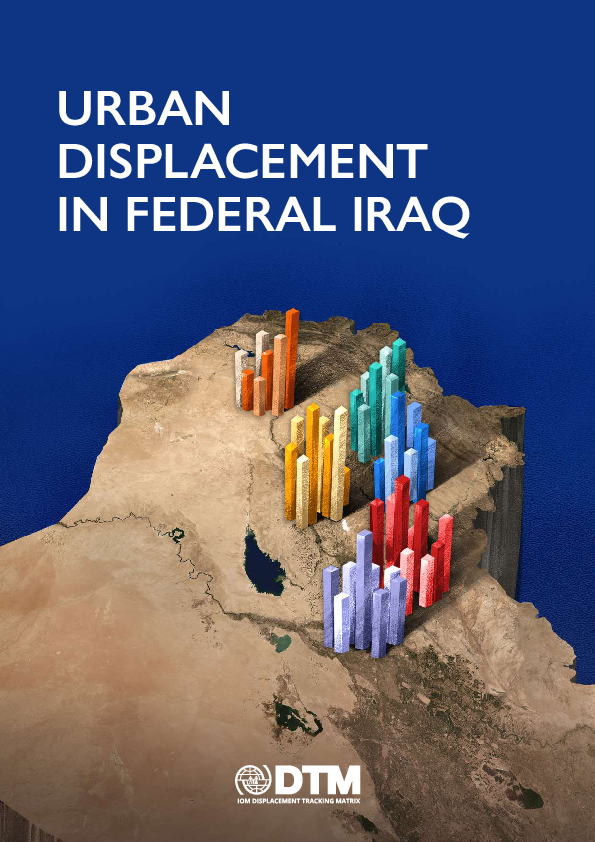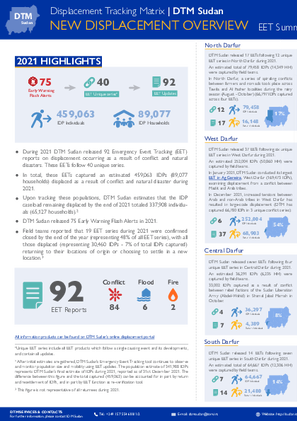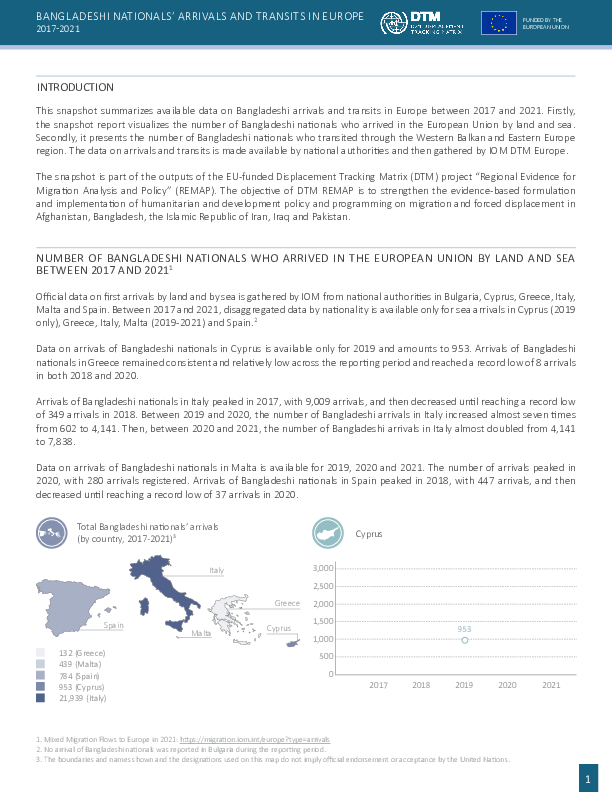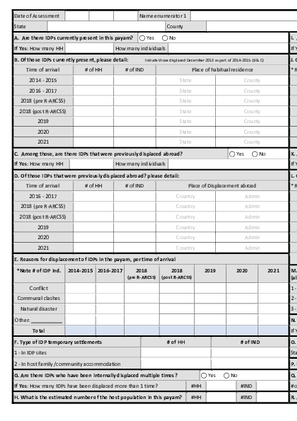-
Countries
-
Data and Analysis
-
Special Focus
-
Crisis Responses

Contact
DTM Afghanistan, DTMKabul@iom.int
Language
English
Location
Afghanistan
Period Covered
Apr 16 2022
Apr 22 2022
Activity
- Flow Monitoring
The snapshot captures present mobility and displacement trends between Afghanistan, the Islamic Republic of Iran and Pakistan.

Contact
IraqDTM@iom.int
Language
English
Location
Iraq
Period Covered
Aug 01 2019
Aug 31 2020
Activity
- Survey
- Baseline Assessment
As displacement within Iraq becomes increasingly protracted for internally displaced persons (IDPs), further research is needed to understand its causes and put forward potential durable solutions. The United Nations (UN) International Organisation for Migration Displacement Tracking Matrix (IOM DTM) undertook this research project “Urban Displacement in Iraq” with the primary objective of supporting evidence-based planning for the humanitarian community and the government of Iraq, and to inform the response to protracted displacement in this post-emergency phase. This report will detail findings from urban centres within the Federal Iraq. An equivalent report is available for urban centres assessed within the Kurdistan Region of Iraq (KRI).
Data for this assessment was collected on a sample of households, representative at the city level (95%, 5%), between March and December 2020. Ten urban centres of Iraq were assessed, namely the cities of Baghdad/ Abu Ghraib, Baquba, Dahuk, Erbil, Kirkuk, Mosul, Sulaymaniyah, Tikrit, Tuz Khurmatu, and Zakho.

Contact
DTM Nigeria, AllUsersInDTMNigeria@iom.int
Language
English
Location
Nigeria
Period Covered
May 07 2022
May 13 2022
Activity
- Mobility Tracking
- Baseline Assessment
- Points of Entry (PoE)
During the COVID-19 pandemic, IOM's Displacement Tracking Matrix (DTM), in collaboration with the World Health Organization (WHO), monitors cross-border movements to and from Nigeria's Borno State in north-east Nigeria. Assessments are conducted at Points of Entry located along the border with Cameroon.
A range of data was collected during the assessments to better inform on travellers’ nationalities, sex, reasons for moving, mode of transportation and timeline of movement as shown in figures 2 to 5 below.

Contact
DTM Nigeria, AllUsersInDTMNigeria@iom.int
Language
English
Location
Nigeria
Period Covered
Apr 01 2022
Apr 30 2022
Activity
- Other
- Displacement Solutions
In recent years, competing claims to natural resources have grown with reports of violent clashes between farmers and herders communities in Adamawa state of Nigeria. The TTT Early Warning monitors transhumant movements and identifies the pattern of alerts that are related to the use of natural resources between farmers and herders. The TTT data collection engages a network of selected Key informants from the Community Response Network (CRN) and LGA-based team leads.
During the month of April 2022, the TTT Early Warning tool captured 285 alerts. The triangulated alerts include 257 (90%) events and 28 (10%) massive/late movements. The recent event alerts were compounded by the rise in the incidences of the burning of farmlands after harvest to create a scarcity of pasture for grazing as well as to discourage the herders grazing on farmland, potentially leading to conflict in the LGAs such as Demsa.
The event alerts spread across 73 per cent of the wards in the 5 operational LGAs. The percentages of the event alerts in each LGAs are Demsa (35%), Numan (24%), Lamurde (18%), Girei (9%), and Mayo-Belwa (5%). For instance, in Lamurde and Numan LGAs, there are reported cases of crop destruction and underage-herders grazing respectively. It is also reported that 9 per cent of the events resulted in casualties or injuries, while less than one per cent of events led to displacements of populations. The highest number of casualties or injuries are reported from Girei followed by Demsa and Lamurde LGAs.
The early warning data indicated some localities where the potential event could occur. As shown on the map, Demsa, Fufore, Jada, Ganye, Hong, Mayo-Belwa, Numan, Toungo, and Yola South LGAs are the potential risk areas in relation to late and massive movements. In Mayo-Belwa LGA more movement alerts were reported than other operational LGAs, mainly because Mayo-Belwa is traversed by the major North-south axis transhumance corridor. In addition, transhumant groups use the Gongoshi grazing reserve as a resting point on their way to and from Toungo LGA where they stay during dry season grazing.
The reported alerts were in many cases, identified, discussed, and on many instances intervened upon during the Community Response Network (CRN), Community Security Architecture Dialogue (CSAD), and Peace Architecture Dialogue (PAD) meetings in order to diffuse escalating tensions and conflicts in the affected community areas.

Contact
DTM Sudan; dtmsudan@iom.int
Language
English
Location
Sudan
Period Covered
Jan 01 2021
Dec 31 2021
Activity
- Mobility Tracking
- Event Tracking
This EET New Displacement Overview provides a summary of the application of the EET methodology during 2021. It provides a breakdown of the number of products DTM Sudan has released under the EET methodology, their geographical findings, cause of displacement breakdown, and overall estimates for displacement and return. Finally, the overview details EET series during 2021 which have been confirmed by DTM Sudan field teams as now being closed - with all associated IDPs having returned to their location of origin or settled in a third location.
DTM Sudan has also released an Interactive Dashboard, where those interested in DTM Sudan's EET findings during 2021 can disaggregate our findings by locality, sex and age demographic, shelter typology, vulnerability, type of EET, and month. This interactive dashboard can be accessed here or via the QR code located in the overview itself.
The DTM Emergency Event Tracking (EET) is deployed to track sudden displacement and population movements, provide more frequent updates on the scale of displacement, and quantify the affected population when needed. As a subcomponent of the new Mobility Tracking methodology in Sudan (Round Three), and activated on a need basis, EET utilises a broad network of key informants to capture best estimates of the affected population presence per location – a useful tool for humanitarian response planning and design.
IOM works with national and local authorities in order to gain a better understanding of population movements throughout Southern Africa. Through the setup of Flow Monitoring Points (FMPs), IOM seeks to quantify migration flows, trends and routes and to gain a better understanding of the profiles of observed individuals at entry, transit or exit points (such as border crossing posts, bus stations, rest areas, police checkpoints and reception centres). This report is an overview of the data collected in these FMPs from 1 to 30 April 2022.
Inter-regional migration from and within the Southern Africa is categorized along the following corridors. The Flow Monitoring Points (FMPs) were set-up in several key transit locations along the corridors to track the movements of passengers:
•Zimbabwe (Mutare) – Mozambique (Manica)
•Zimbabwe – Zambia (Chirundu)
•Zimbabwe – Botswana (Plumtree)
•Zimbabwe (Beitbridge) – South Africa
•Malawi (Mchinji) - Zambia (Mwami)
•Malawi (Karonga ) – United Republic of Tanzania
•Malawi (Mwanza) – Mozambique (Zobue)
•Malawi (Mulanje) – Mozambique
•Mozambique (Ressano Garcia) – South Africa
Over the reporting period a total of 68,733 movements were observed across 48 FMPs in the region. The Zimbabwe – South Africa corridor hosted the largest number of movements with 43,482 (63%) followed by the Malawi (Mwanza) – Mozambique (Zobue) corridor with 8,507 (12%) and the Zimbabwe – Zambia corridor with 3,858 movements reported (6%).

Contact
DTM Sudan; dtmsudan@iom.int
Language
English
Location
Sudan
Snapshot Date
May 12 2022
Activity
- Mobility Tracking
- Event Tracking
The DTM Emergency Event Tracking (EET) is deployed to track sudden displacement and population movements, provide more frequent updates on the scale of displacement, and quantify the affected population when needed. As a subcomponent of the new Mobility Tracking methodology in Sudan (Round Three), and activated on a need basis, EET utilises a broad network of key informants to capture best estimates of the affected population presence per location – a useful tool for humanitarian response planning and design.

Contact
IraqDTM@iom.int
Language
English
Location
Iraq
Period Covered
Oct 01 2019
Dec 31 2019
Activity
- Mobility Tracking
- Baseline Assessment
As the context in Iraq shifts from a humanitarian emergency to a protracted displacement crisis, more than 1.4 million people remain displaced throughout the country as of December 2019.
Further information is required to better understand the underlying causes of protracted displacement and the actions needed to enable durable solutions – whether to return to areas of origin (AoO), integrate into areas of displacement (AoD), or move to a third location. IOM Displacement Tracking Matrix (DTM), the Returns Working Group (RWG) and Social Inquiry (SI) have been working toward this objective, producing in November 2018 the first report “Reasons to Remain: Categorizing Protracted Displacement in Iraq,” which established a categorization framework for protracted displacement to enable future study. This report was followed by a number of publications on this topic, aiming among other things to identify the number of internally displaced persons (IDPs) that fall into each category, where they can be found, and most importantly, where they are from. Nonetheless, information gaps remain in terms of understanding displacement in urban contexts where a large proportion of IDP families are concentrated throughout the country.
To address this gap, DTM now aims to establish a breakdown of the remaining out-of-camp IDP caseload in the main urban centres of displacement to better understand the potential for durable solutions. Ten urban locations across eight of the main governorates of displacement have been selected for the assessment: Erbil city, Mosul city, Kirkuk city, Sulaymaniyah metropolitan, Baghdad city + Abu Graib, Zakho town, Dahuk city, Tooz Khormatu town, Tikrit city and Baquba city.

Contact
REMAPBD@iom.int
Language
English
Location
Bangladesh
Period Covered
Jan 01 2017
Dec 31 2021
Activity
- Flow Monitoring
This snapshot summarizes available data on Bangladeshi arrivals and transits in Europe between 2017 and 2021. Firstly, the snapshot report visualizes the number of Bangladeshi nationals who arrived in the European Union by land and sea. Secondly, it presents the number of Bangladeshi nationals who transited through the Western Balkan and Eastern Europe region. The data on arrivals and transits is made available by national authorities and then gathered by IOM DTM Europe.
The snapshot is part of the outputs of the EU-funded Displacement Tracking Matrix (DTM) project “Regional Evidence for Migration Analysis and Policy” (REMAP). The objective of DTM REMAP is to strengthen the evidence-based formulation and implementation of humanitarian and development policy and programming on migration and forced displacement in Afghanistan, Bangladesh, the Islamic Republic of Iran, Iraq and Pakistan.


